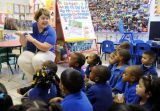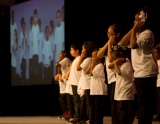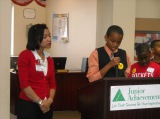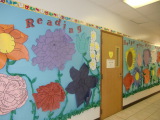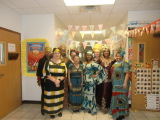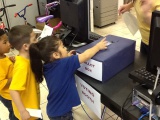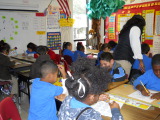-
Category 1
Selected in 2012
-
Grades: pre k - 5
School Setting: urban
Town Population: 6,000,000
Student Enrollment: 130
Student Demographics:
Black/African American: 62%
Teacher/Student Ratio: 1:18
White/Caucasian: 3%
Hispanic: 33%
Hawaiian/Pacific Islander: 0%
Asian: 0%
Native American: 0%
Other: 2%
% Reduced Lunch: 98%
% ELL Learners: 24%
Founded: 1989 -
PRINCIPAL:
Yvette East -
CONTACT:
902 West 8th Street
Houston, TX 77007
713-869-9453
llacy@heightslearning.org
Houston Heights Learning Academy
Houston, TX
In all subjects, we use elaborative interrogations to make sure all vocabulary is understood. This promotes critical thinking and ensuring that students understand the entire concept and not just individual word definitions. It simplifies generalizations and gives the teacher the opportunity to assess the reasoning behind the response which generates elaborate answers. It assists students with absorbing new knowledge and creates interaction.
- Describe specific programs in place to ensure that families are involved in the success of your school and students.
-
Shared decision making is a collaborative effort driven by mutual cooperation and respect, and is the process used by Houston Heights Learning Academy and its stakeholders as they make major decisions that impact the entire school.
Teachers look at prior year’s assessments, monitoring reports, achievements, and parental surveys to determine areas of strengths and weaknesses in the academic success of all students on campus. Meetings and opportunities for parents to “sit-in: on instruction, Making sure goals are realistic determined by instruction. “Progress reports are sent to the parents every 3 weeks and parent teacher conferences are 6 times a year. Parents are also welcomed to schedule an appointment to speak with the teacher during their assigned planning time, email or Skype.
Teachers and parents are encouraged to attend conferences and workshops that target TEKS based curriculum each year .Teachers and parents are given an opportunity to discuss and share what is learned during staff and parent meetings.
The state legislature creates the laws effecting Texas Education whether it is curriculum or budget. We found it is very important to involve our parents on this level as well. .This provided an opportunity to network with other parents of other charter schools as well. In return, it inspired a visit to the school from State Representative Jessica Farrar who had breakfast with the parents from that event. From that experience, we have partnered with Stand for Children to create a civics class for parents. Stand for Children also provides additional services for our parents including classes of various interests.
Students, parents, and stakeholders come together to share a multitude of activities. For example: Field Day, Fire Safety Day, Muffins for Moms, Donut for Dads, Math and Science Night, and the 100 Day celebration all give opportunities for parents to be involved in student learning. Our annual festival held the 3rd Saturday in October brings the entire community together to receive their flu shots, cholesterol, prostrate, immunizations, diabetes screening, eyes and teeth screenings. All screenings are free of charge. The community supports us and local businesses provide raffle prizes and sponsorships.
Houston Heights reaches out to parents, families and the community. We are actively engaged in partnerships with the Greater Heights Chamber of Commerce, Heights Education Committee, realtors, and churches. We continually communicate through the school website, newsletters, flyers, and brochures, emails and telephone calls as all stakeholders work toward school success. - What is the single most important factor in the success of your school that others could replicate?
-
Houston Heights Learning Academy’s strengths is in meeting each student where they are and helping them grow. This is the most important factor in the success of our school. The student population has a diverse range of ability and each teacher works to provide an environment where instruction is adjusted to meet the needs of the individual student, especially the ELL and Special Education students in a variety of ways. The school concentrates on differentiated programs. All teachers focus on declarative and procedural knowledge. At the beginning of the year, each teacher evaluates the students using informal assessments, testing and group discussions to determine the level of understanding of each student. From there, lessons are tailored to help each student achieve and grow in all areas of content subjects by making a distinction between learning goals activities and using the appropriate differentiated approach to meet the students need. Additionally, the students must take ownership in learning by tracking their own progress.
In all subjects, we use elaborative interrogations to make sure all vocabulary is understood. This promotes critical thinking and ensuring that students understand the entire concepts and not just individual word definitions. It simplifies generalizations and gives the teacher the opportunity to assess the reasoning behind the response which generates elaborate answers. It assists students with absorbing new knowledge and creates interaction.
Additionally, Core Knowledge our scope and sequence is aligned to the regular curriculum to promote a deeper understanding in each subject area. This is done by integrating subject areas together and moving each student to a higher level of understanding of application and evaluation. This cross- curriculum study reinforces student learning across all subject areas.
Every student is exposed to a wide variety of writing experiences in all subjects by way of journals, persuasive essays, fiction stories, and research based information. Poetry is used to help the ELL and special education student understand figurative language and many other language skills. Graphic organizers are used to help with sequencing and vocabulary, such as story webs and outlines. Technology is interwoven into classroom instruction and also is used as support to further supplement the lesson. Frequent informal and formal assessment is given during every lesson to track students’ progress, and early intervention is given as needed to ensure that mastery of each concept is reached. - Describe the program or initiative that has had the greatest positive effect on student achievement.
-
Our Science iniative has had the greatest effect on student acheivement.
In 2007, Science scores increased from 17 % to 83% on the Science TAKS (Texas Assessment of Knowledge and Skills) our state assessment. Since that time, students have scored 90% or greater.
Studies have shown that young children learn best through hands-on experimentation and an integration of other subjects into the science curriculum. We teach concepts to cover many areas of science and to include mathematics whenever possible. We deliver science instruction using the 5-E Instructional Teaching Model which is made up of the 5- steps sequence for teaching and learning: Engage, Explore, Explain, Elaborate, and Evaluate. We involve our students in science activities and experiments that utilize experimental design, which encourages observation, exploration, questioning, hypothesizing, experimentation, analyzing and reporting of data.
Our students will typically be seen conducting science experiments in cooperative groups with each student playing a vital and specific role in the experimentation process. The children take charge of the experiments while the teacher simply acts as a monitor and a guide, giving suggestions whenever necessary. This strategy develops problem- solving skills, independent-thinking skills, teamwork and confidence within the students.
We vary teaching methods by mixing our traditional curriculum, McGraw – Hill science, with kid-designed science videos and shows that provide a fresh and exciting perspective on science. Students are strongly encouraged to use artwork with detailed explanation and description as a strategy for mastery of key concepts. Discussions about discoveries made by scientist from different ethnic and personal backgrounds, including gender, are often carried out. We believe the knowledge that scientist come from diverse backgrounds may serve as an encouragement to students to strive harder and develop confidence in their abilities.
Our Science collaborates with other Science teachers from other schools on a weekly basis sharing best practices, strategic methods, and new technologies on current science objectives.
Parental involvement plays a very important part in children’s education. We offer parents the opportunity to contribute to their children’s education through monthly projects. Students are required to complete a project a month on predetermined topics previously taught in class. As part of our ongoing effort to provide the best education for all students, we integrate technology in our science curriculum for research on projects, introduction of new concepts and for remediation. - Identify the professional development activities you use to improve the teaching portion of the teaching and learning process.
-
Teachers are lifelong learners. “Develop a passion for learning and you’ll never cease to grow” is our belief. Our professional development is data driven and aligned to our campus/district improvement plan and instructional needs assessment. A staff development plan and calendar is created for all employees including administration. This is done to target the needs of all students, teachers, and stakeholders. Houston Heights Learning Academy professional development focuses on best practices and research based content to fine-tune teacher classroom practices and student achievement. Our aim is for all teachers to be prepared with the accurate knowledge which will benefit our students academically, emotionally and socially in building a strong foundation in becoming successful global citizens of the world.
Houston Heights Learning Academy detects deficits in a variety of ways from evaluations, classroom observations, student results, and above all, personal teacher resolutions. On Fridays, teachers participate in campus based professional development. Teachers, administrators, or education consultants share best practices on effective classroom pedagogy in certain areas to be improved upon. All teachers come to the table with something to share. There are several in-house resources. The Reading Coach is reinforcement to the school-wide reading curriculum “Imagine It” as she outlines plans to enhance fluency, comprehension, critical thinking skills through Marzano’s high yielding strategies. The ELL Coordinator offers support in promoting successful achievement with limited English speakers. The Title I Coordinator proposes helpful information in increasing school-wide parent involvement activities and field lessons. Moreover, thought provoking book studies are led by teachers.
Staff development is continued and accessible throughout the year. Teachers are given the opportunity to attend state and national conferences such as the Texas Charter Conference, Core Knowledge, Conference for the Advancement of Science Teaching, and the Hope foundation just to name a few. It is required of each teacher to obtain a minimum of 45 hours of professional development to make certain that our school provides the absolute best education for our students. Yet, Houston Heights supersedes these mandated hours. We are actively involved with weekly professional learning communities and partnerships which provide a forum for discussion and trainings. The staff attends local universities, regional educational service centers, and literary institutions that provide a continuum of growth for all involved which encourage efficient education to mold the minds of students towards an exemplary status. - Describe how data is used to improve student achievement and inform decision making.
-
Houston Heights Learning Academy uses a variety of assessment data. We believe that assessment drives instruction. At the beginning of each year, teachers review the results from the state assessment. The scores are disaggregated and analyzed for interpretation to understand the complexity of what was tested, mastered, and deficient for each student. The staff looks for learning gaps and growth patterns. This information is then aligned to prior year and current year objectives to determine pacing and content for core academic areas as well as differentiated instruction.
During the third week of school, all students from Kindergarten to grade 5 are given the Iowa Test of Basic Skills [ITBS] a norm reference assessment to identify specific strengths and weakness in the areas math, reading, language, science in social studies to provide grade and norm curve equivalents.
This assessment offers a more complete picture of ascertaining student performance. It is compares the end of the prior year’s results to examine consistency, growth or loss. Also, it is used to create plans for targeting intervention and tracking progress because it is given again at the end of the year. The teachers review the information to determine gaps in curriculum and design lesson plans to accelerate instruction to meet the needs of the students.
The teachers are able to group students by ability and mixed ability per subject and provide appropriate interventions such as tutorials to produce maximum results for student success.
Additonally, we focus on the curriculum in 4 different areas: 1) the curriculum content 2) the instruction of the teacher 3) the learner 4) the learning evironment
When we look at the lessons in the curriculum, we look at the learning objective and evaluate in the classrooms on whether these objectives are obvious, and evident in students work. Then, we look at the student to find out if the students understanding is aligned to the objective itself and not just the activity.
As we focus on instruction, we zoom into the instructional practices (explicitly what type of instruction and strategies) and look at the grouping format of the students and instructional materials.
Additionally, student response to instruction is identified by observing the level of engagement and cognitive difficulty.
Furthermore, we look at the classroom environment for learning. We utilize this data to identify what type of learning is evident. This bi- weekly data allows the teachers to prepare lessons according to the needs of all students across grade levels.
The TPRI Texas Primary Inventory examines the skills of the learner and whether the key concepts of all fundamental areas of reading have been mastered. It measures fluency; implicit and explicit understand of concepts read, vocabulary and phonemic awareness. It is given 3 times a year and weekly process monitoring is done through various formative assessments. Summative assessments are given once progress is determined to verify learning. The reading coach works with students that are still developing key concepts in small groups and individualized instruction on a daily basis in a program called BURST.
The Prekindergarten uses a continuous progress monitoring tool that was created by the University of Texas Children's Institute. The CIRCLE assessment evaluates the students’ ability to recognize letter, sounds, social skills, and numbers to determine school readiness for kindergarten. The Prekindergarten teachers find this tool useful in identifying instructional groups and documenting student development.
All of this data allows us to grow each child forward. - Describe your school culture and explain changes you’ve taken to improve it.
-
Houston Arts Learning Academy has a liberal arts program. Of course we utilize our state curriculum which is the TEKS, but it is how we integrate the curriculum that ignites the learning. We use innovative techniques to teach and motivate students to venerate knowledge. Our curriculum is centered on integrated thematic units and experiential learning. The students receive a classical education that seamlessly builds their body of knowledge and skills from one year to the next which connect across grade levels and content areas. Additionally, the students are taught leadership and cooperative skills, through varied experiences which cultivate many facets of learning. We also utilize a Russian internet math program which instills a complete understanding of mathematics tailored to their specific needs for grades three through five. Additional web-based/white board programs are used to supplement our school wide math and reading programs for students in grades 2 through five. These programs offer instruction and reinforcement also in the subjects of writing, and science. Sustaining the students interests through technological innovations is not the only way that we deepen the child’s love for learning, we heavily rely on the tried and true methods of consistent high quality differentiated instruction, project based lessons, teacher collaboration and development, and parental involvement.
Passion, commitment, and implementation make the difference, it is our strength. We continuously look for ways to improve teaching skills so that the students will not just learn for the moment, but for a lifetime. Our team meets weekly to discuss the needs of the children from grade to grade as well as for advice and support for the classroom. Because we do not have extra staff, we all must be able to bear the weight of extra duties which only enhances our abilities to best serve the students. Additionally, we have developed professional learning communities with several traditional public and charter schools which enable us to collaborate on ideas that work best in the elementary science and math classroom to produce proficient young scientists, and or mathematicians. The administration also searches for teacher development opportunities with research proven results that are truly meaningful to the teacher which proves to enhance student’s development as well utilizing the school motto "changing for the better".
Stats
-
Category 1
Selected in 2012
-
Grades: pre k - 5
School Setting: urban
Town Population: 6,000,000
Student Enrollment: 130
Student Demographics:
Black/African American: 62%
Teacher/Student Ratio: 1:18
White/Caucasian: 3%
Hispanic: 33%
Hawaiian/Pacific Islander: 0%
Asian: 0%
Native American: 0%
Other: 2%
% Reduced Lunch: 98%
% ELL Learners: 24%
Founded: 1989 -
PRINCIPAL:
Yvette East -
CONTACT:
902 West 8th Street
Houston, TX 77007
713-869-9453
llacy@heightslearning.org


